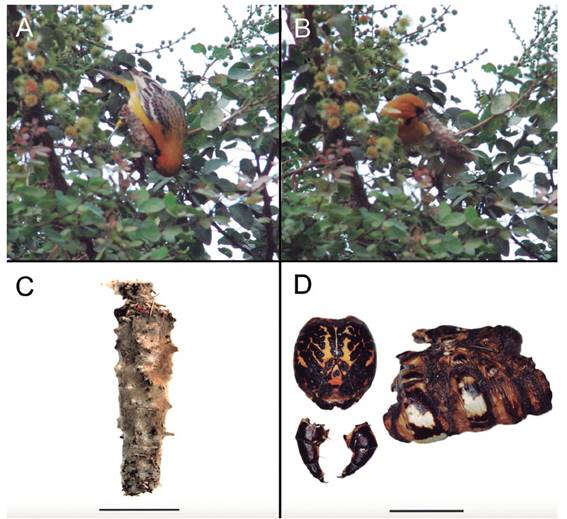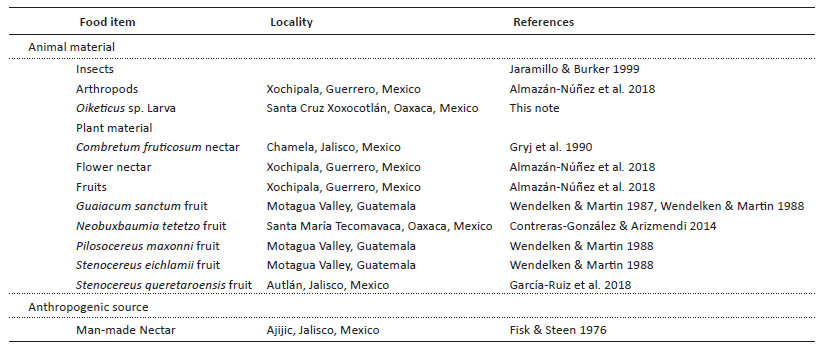INTRODUCTION
The Streak-backed Oriole Icterus pustulatus (Wagler, 1829) is a species of passerine bird (Icteridae) that is distributed from western Mexico to northwestern Costa Rica (Jaramillo et al. 1999). In Mexico, it occurs on Pacific slope from sea level to 1800 m snm (Howell & Webb 1995), where it inhabits dry deciduous forests and subdeciduous thorn forests, scrub, mangroves, plantations, and gardens (Howell & Webb 1995, Skutch 1996, Jaramillo et al. 1999, Vallely & Dyer 2019). Typically, foraging occurs in pairs or small groups, often with the Baltimore Oriole Icterus gularis and the Spot-breasted Oriole Icterus pectoralis (Howell & Webb 1995, Skutch 1996, Vallely & Dyer 2019). Records on the diet of the Streak-backed Oriole are limited and it has been considered as insectivorous-frugivorous (Jaramillo et al. 1999, Palomera-García et al. 1994) or omnivorous and granivorous (Almazán-Núñez et al. 2018). Plant materials are a fundamental component of its diet, specifically fruits, seeds, and nectar (Almazán-Núñez et al. 2018). Arthropods has also been reported in the diet, which are obtained from pruning live foliage, inside rolled leaves, or tree inflorescences (Jaramillo et al. 1999, Almazán-Núñez et al. 2018).
The genus Oiketicus (Lepidoptera: Psychidae) is largely a neotropical group (Davis 1975) and its members are an important pests of tropical crops in this region (Davis 1964, Rhainds & Cabrera-La Rosa 2010). Arthropods (ants and arachnids) and vertebrates (Lizards, Anolis, and probably woodpeckers) are known to feed on Oiketicus larvae; however, only birds have been noted eating both the larvae and adults of Oiketicus (Davis 1964). Due to the literature on the diet of I. pustulatus is scattered and still very limited, herein, we review its diet and report the first case of predation by this species on the bagworm moth Oiketicus sp. (Lepidoptera: Psychidae).
MATERIAL AND METHODS
Review of the diet. We searched the literature for diet studies of I. pustulatus across various academic databases, including the Biodiversity Heritage Library, Google Scholar, Scielo, and Scopus.
Observation and new prey. Our field observations were recorded with a Canon Rebel T7, lens EF 75-300 mm in Nazareno, Municipality of Santa Cruz Xoxocotlán, Oaxaca, Mexico (17°01’07.2”N, 96°45’19.5”W, 1549 m of altitude), where the dominant vegetation is xerophytic. For a more detailed description of the area, see Julián-Caballero (2021). We identified the bird species following Skutch (1996). To ascertain the taxonomic classification of the prey, we manually retrieved the insect casing that was being preyed upon and utilized laboratory scissors to extract the contents from within. The ImageJ software (Abràmoff et al. 2004) was utilized to measure the bag and head capsule width of the insect. Subsequently, we identified the prey as a bagworm moth larva following Davis (1964).
RESULTS
Review of the diet. Animal, plant, and anthropogenic material were identified in previous research on the dietary habits of this species. Many of these studies were conducted in Mexico and highlight Stenocereus (Cactaceae) as a significant food source for the Streak-Backed Oriole (Table 1).
Observation and new prey. At 18:11 h on 1 January 2022, we observed an individual of I. pustulatus vocalizing at 2 m above the ground on a branch of Pithecellobium dulce (Fabaceae). The observation was made from approximately 13 m. The bird was looking for food inside an insect bag. The Streak-backed Oriole was using either its right or left foot to hold onto its perch, while hanging its head downward. The bird rotated the bag to the left using its bill (Fig. 1A), then used a gaping motion of its bill to open the base of the bag (Fig. 1B), ultimately obtaining the contents within approximately 10 min. The upper portion of the bag was attached to a P. dulce branch and made up of natural plant materials, such as leaves and twigs (Fig. 1C). The length of the bag was 70.6 mm. Upon examination, insect fragments were found inside the bag at the top, including a head capsule measuring 11.2 mm in width, a pair of thoracic legs, and thoracic segments (Fig. 1D). Based on the morphological characteristics of the bag and the examination of the fragments contained within, we determined that the Streak-backed Oriole had consumed Oiketicus sp. larva.

Figure 1 Feeding behavior and new prey item of the Streaked-backed Oriole Icterus pustulatus as described by observations from Nazareno, Municipality of Santa Cruz Xoxocotlán, Oaxaca, Mexico. A) Streaked-Backed Oriole turning the bag to the left with its bill. B) Streaked-Backed Oriole perforating the base of the bag with its bill. C) The bagworm case is seen pierced with a hole made by I. pustulatus to extract the contents. D) Examples of fragments of prey that were recovered from inside the bag after the observed predation event (head capsule, a pair of thoracic legs, and thoracic segments). Photos: César Camilo Julián-Caballero. Scale bars: C = 30 mm, D = 10 mm.
DISCUSSION
The Streak-backed Oriole could be considered as an omnivores species and this is the first report of an individual predating on bagworm moth Oiketicus sp. (Lepidoptera: Psychidae). Larva found in this work was unambiguously identified to the genus Oiketicus based on morphological characteristics of the bag, a head capsule pigmented with yellow and brown colors, and a white thorax (Fig. 1D) (Davis 1964, 1975). We did not find lepidopterans in the diet of I. pustulatus in our review (Table 1). Nevertheless, lepidopterans have been reported in the diets of the Baltimore Oriole I. galbula (Timken 1970, Skutch 1996) and the Orchard Oriole I. spurius (Scharf & Kren 1997).
Baltimore Orioles have been observed eating caterpillars (Timken 1970) by opening insect bags to extract the larvae (Skutch 1996). The foraging method of the Streak-backed Oriole, described in this note, aligns with previous references of orioles feeding on insects and nectar by gleaning foliage and probing curled leaves while hanging upside down (Skutch 1996, Scharf & Kren 1997, Jaramillo et al. 1999). These slender birds often feed by gaping (Remsen & Robinson, 1990), inserting their closed bills into large tubular flowers, fruits, or stems, then opening the bill to facilitate nectar feeding or to expose food (Skutch 1996), as described in our current observation (Fig. 1B). In the present observation, we note that most bill attacks seemed to be directed at the soft part (abdomen) of the larva. The Black-backed Oriole Icterus abeillei is known to consume only the soft parts of monarch butterflies in Mexico (Fink et al. 1983). Predation records are important for understanding the behavior and feeding strategies of birds within their habitats. In conclusion, this study provides a checklist of previous foot items recorded in the diet of I. pustulatus and adds a new prey, the bagworm moth Oiketicus sp. (Lepidoptera: Psychidae), from an observation in Mexico.












 uBio
uBio 



